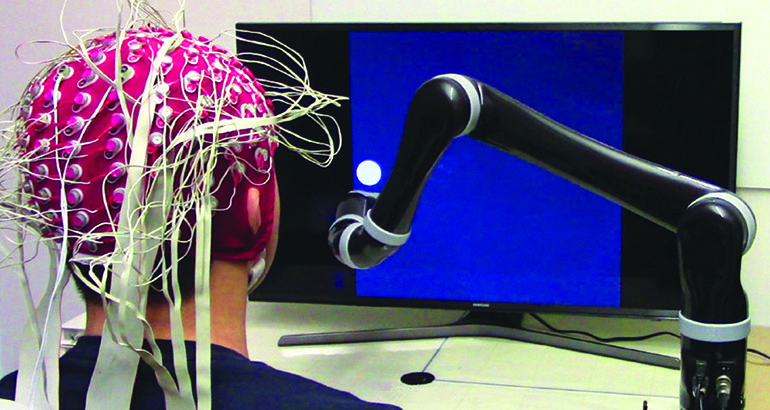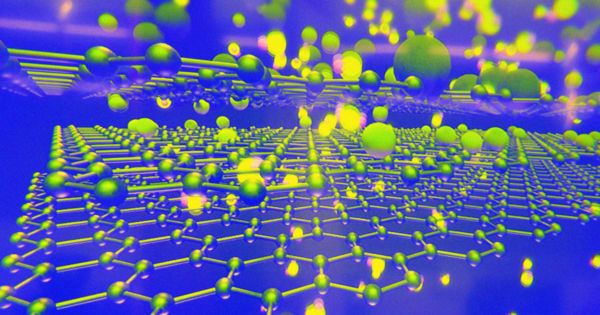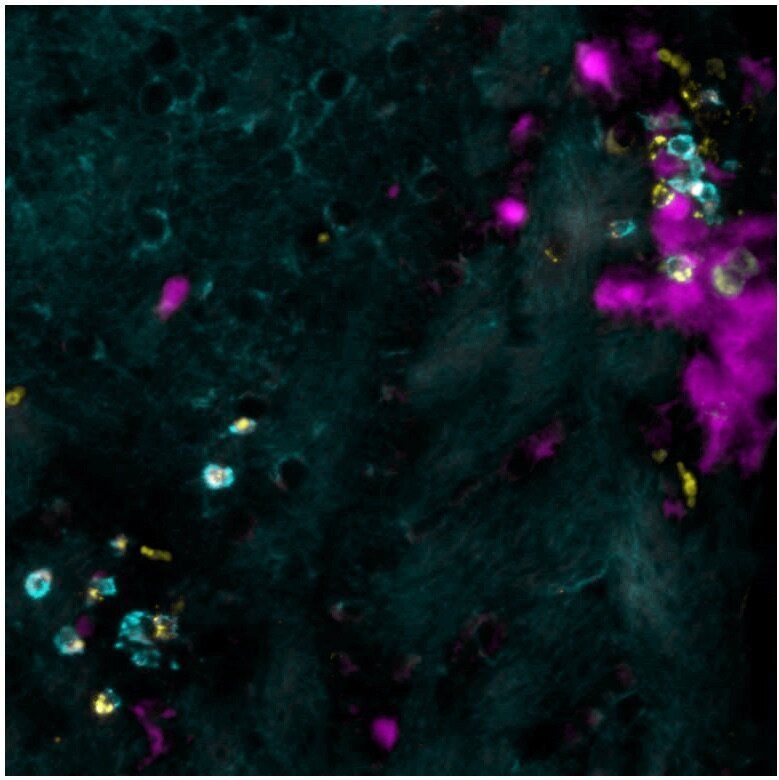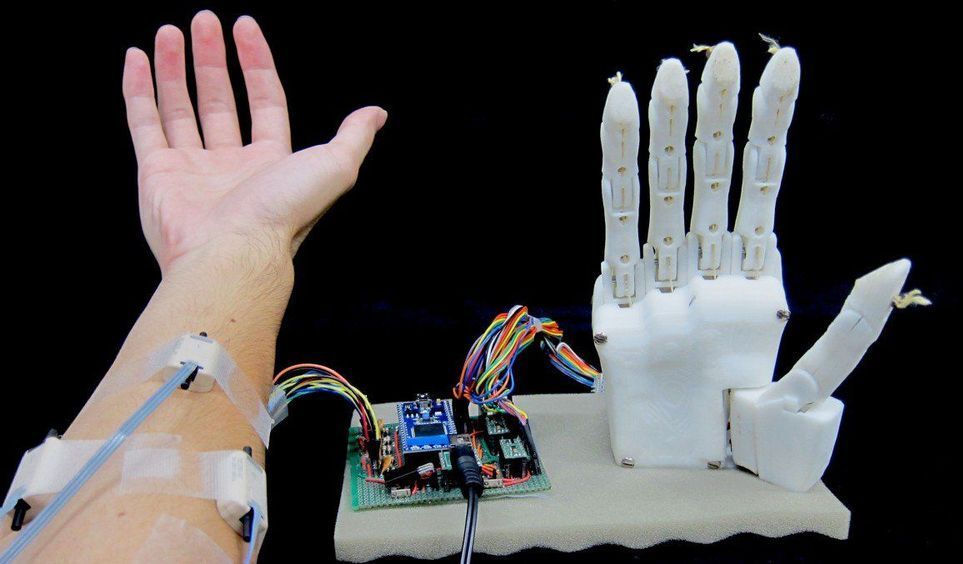Page 7635
Jun 28, 2019
I welcomed our new robot overlords at Amazon’s first AI conference
Posted by Genevieve Klien in categories: robotics/AI, space
Jun 28, 2019
Severely Disabled People Mind-Control a Robotic Arm via EEG
Posted by Genevieve Klien in categories: biotech/medical, robotics/AI

Scientific collaborators from Carnegie Mellon University and University of Minnesota have created a way for people to control a robotic arm using a non-invasive brain-computer interface (BCI). Previously, electrode array implants in the brain have been necessary to give severely disabled people the ability to manipulate an external robot. That is because implants can gather more actionable signal information by being placed right on the surface of the brain. Avoiding dangerously invasive brain surgery to place these implants, though, is a big goal in the field of brain-computer interfaces.
The Carnegie Mellon team turned to newly developed sensing and machine learning methods to accurately read signals coming from deep within the brain, relying only on an external electroencephalography cap for signal gathering. The system can quickly improve both its performance and that of the person using it, to achieve drastically better results than previous solutions. Volunteers using the technology were put through a pursuit task and a training regimen to improve their engagement, while the system was performing an analysis of their brain signals.
Continue reading “Severely Disabled People Mind-Control a Robotic Arm via EEG” »
Jun 28, 2019
Is multiple sclerosis linked to childhood viral infections?
Posted by Genevieve Klien in categories: biotech/medical, genetics, neuroscience
Although the exact causes of multiple sclerosis still remain unknown, it is assumed that the disease is triggered by a combination of genetic and environmental risk factors. But which? In a mouse model of the disease, researchers at the University of Geneva (UNIGE) and the Geneva University Hospitals (HUG), Switzerland, studied the potential link between transient cerebral viral infections in early childhood and the development of this cerebral autoimmune disease later in life. Indeed, the brain area affected by viral infection during childhood undergoes a change that can call, a long time later, on the immune system to turn against itself at this precise location, triggering autoimmune lesions. These results, which are published in the journal Science Translational Medicine, provide a first step in answering one of the possible environmental causes of this serious disease.
Multiple sclerosis affects one in 1,000 people in Switzerland, two-thirds of whom are women. It is the most common auto-immune disease affecting the brain. Up to date, there is still neither a cure available, nor a clear understanding of the factors that trigger this disease at around 30 years of age. “We asked ourselves whether brain viral infections that could be contracted in early childhood were among the possible causes,” says Doron Merkler, a professor in the Department of Pathology and Immunology in UNIGE’s Faculty of Medicine and senior consultant in the Clinical Pathology Service of the HUG. Such transient brain infections can be controlled quickly by the immune system, without the affected individual even noticing any symptoms. “But these transient infections may, under certain circumstances, leave a local footprint, an inflammatory signature, in the brain,” continues the researcher.
Jun 28, 2019
Meet Dragonfly! NASA’s Rotorcraft Lander Mission to Titan
Posted by Alberto Lao in category: space travel

On June 27, 2019, NASA announced a new mission to Saturn’s moon Titan featuring a rotorcraft lander. — Mission was proposed in 2017: https://www.space.com/36598-dragonfly-quadcopter-saturn-moon-titan-explorer.html
Credit: NASA
Calico is a research and development company whose mission is to harness advanced technologies to increase our understanding of the biology that controls lifespan.
Jun 27, 2019
Machine learning makes a better Luke Skywalker hand
Posted by Saúl Morales Rodriguéz in categories: 3D printing, biotech/medical, cyborgs, robotics/AI, transhumanism
A 3D-printed prosthetic hand controlled using a new AI-based approach could significantly lower the cost of bionic limbs for amputees.
Real need: There are approximately 540,000 upper-limb amputees in the United States, but sophisticated “myoelectric” prosthetics, controlled by muscle contractions, are still very expensive. Such devices cost between $25,000 and $75,000 (not including maintenance and repair), and they can be difficult to use because it is hard for software to distinguish between different muscle flexes.
Handy invention: Researchers in Japan came up with a cheaper, smarter myoelectric device. Their five-fingered, 3D-printed hand is controlled using a neural network trained to recognize combined signals—or, as they call them, “muscle synergies.” Details of the bionic hand are published today in the journal Science Robotics.
Magnetic actuation of keyboards can have almost an infinite number of keystrokes.
The ultimate entry-level gaming keyboard featuring individually programmable backlit keys Powered by Razer Chroma for full personalization and performance.
Jun 27, 2019
Functional hair follicles grown from stem cells
Posted by Quinn Sena in categories: biotech/medical, genetics, life extension, neuroscience
Scientists from Sanford Burnham Prebys have created natural-looking hair that grows through the skin using human induced pluripotent stem cells (iPSCs), a major scientific achievement that could revolutionize the hair growth industry. The findings were presented today at the annual meeting of the International Society for Stem Cell Research (ISSCR) and received a Merit Award. A newly formed company, Stemson Therapeutics, has licensed the technology.
More than 80 million men, women and children in the United States experience hair loss. Genetics, aging, childbirth, cancer treatment, burn injuries and medical disorders such as alopecia can cause the condition. Hair loss is often associated with emotional distress that can reduce quality of life and lead to anxiety and depression.
“Our new protocol described today overcomes key technological challenges that kept our discovery from real-world use,” says Alexey Terskikh, Ph.D., an associate professor in Sanford Burnham Prebys’ Development, Aging and Regeneration Program and the co-founder and chief scientific officer of Stemson Therapeutics. “Now we have a robust, highly controlled method for generating natural-looking hair that grows through the skin using an unlimited source of human iPSC-derived dermal papilla cells. This is a critical breakthrough in the development of cell-based hair-loss therapies and the regenerative medicine field.”
Jun 27, 2019
Physicists ‘teleport’ logic operation between separated ions
Posted by Quinn Sena in categories: computing, particle physics, quantum physics, space
Physicists at the National Institute of Standards and Technology (NIST) have teleported a computer circuit instruction known as a quantum logic operation between two separated ions (electrically charged atoms), showcasing how quantum computer programs could carry out tasks in future large-scale quantum networks.
Quantum teleportation transfers data from one quantum system (such as an ion) to another (such as a second ion), even if the two are completely isolated from each other, like two books in the basements of separate buildings. In this real-life form of teleportation, only quantum information, not matter, is transported, as opposed to the Star Trek version of “beaming” entire human beings from, say, a spaceship to a planet.
Teleportation of quantum data has been demonstrated previously with ions and a variety of other quantum systems. But the new work is the first to teleport a complete quantum logic operation using ions, a leading candidate for the architecture of future quantum computers. The experiments are described in the May 31 issue of Science.















